Whether you’re road biking, hitting single-track trails on a mountain bike, or going for a casual stroll on a hybrid or cruiser, tire pressure is one of the most important aspects to pay attention to, regardless of when or where you’re riding.
Your tires are the only thing between you and the ground, so it's always best to be sure that they are inflated properly for your current riding situation and preferences.
If you ride on even a somewhat frequent basis, you need to be checking your tire pressure on a consistent basis. This almost always includes the use of an actual tire pressure gauge so you can be precise with things.
However, it’s safe to say that you may not always have a tire pressure gauge on you during certain riding situations, so you need to be able to at least provide an estimate without using any kind of tools.
Below, we’ll go over how to check your tire pressure, both with and without a tire pressure gauge.
Regardless of what type of bike you’re riding, the tires will always have a specific range on the side of them for you to reference. First, find this range before using a gauge or inflating.
Once you know the psi range, use your tire gauge by placing it on the valve and pressing down, causing the needle on the gauge to move and display the pressure. Alternate between the air pump and gauge until you reach the desired pressure.
To make things easier, get a pump with a built-in gauge.
While you may not be able to get a precise readout of tire pressure without a gauge, there are still some ways you can improvise.
If you are on a road bike, you can simply squeeze the tire on each side. If there is a lot of giving, inflate until you can barely squeeze it.
For a mountain bike, get on the bike and look down. If you see the tires protruding out on each side more than a millimetre or two, you’ll need to add air. If they feel rock hard and offer no give, you need to relieve some of the air out.
Different types of bike tires require different pressures. As a general rule of thumb, road tires usually need 80 to 130 psi, mountain bike tires require about 25 to 35 psi, and hybrid tires, 50 to 70 psi.
Weather can play a factor in your tire pressure as well. For instance, each 10-degree-Fahrenheit drop in outside temperature correlates to a 2 percent drop in tire pressure. An example of this would be the outside temperature dropping from 90 degrees to 60 degrees, which means your road tire pressure would drop from 100 psi to 94 psi.
An example of this would be the outside temperature dropping from 90 degrees to 60 degrees, which means your road tire pressure would drop from 100 psi to 94 psi.
Also, the surface you’re riding on plays a factor too. If you’re on a road bike, and you are riding on a very smooth road, you can keep the psi up to a maximum level. Rougher roads will require a slight drop in pressure to offer a smoother ride.
If you’re on a mountain bike and you are going to be tackling some adventurous single-track that has uneven surfaces and plenty of sand and dirt, dropping your psi a bit can give the bike better traction and grip.
Bodyweight is another factor. Let’s say that a 165-pound rider uses 100 psi on his road bike. With that point of reference, a 200-pound rider inflates to around 120 psi, while a 130-pound rider could probably ride as low as 80 psi.
In any situation, never go above or below the manufacturer's recommended tire pressures.
Road bikes and tires are designed to go fast on flat ground. Higher air pressure allows them to roll more easily and quickly. These typically have a pressure range of 80 to 130 psi, while racers might go as high as 160 psi. If you're stuck inflating a road tire without a gauge and need to guess, a tire can barely be compressed with your thumb at 100 psi.
Mountain bikes, unlike road bikes, fly over rough, uneven terrain. Too much air in the tires causes too much bounce, resulting in a jarring ride. Lower tire pressure improves shock absorption while also increasing traction by allowing more of the tire to make contact with the ground. Most MTB manufacturers recommend a tire pressure of 30 to 50 psi because it is a good compromise between on-road (closer to 50) and off-road (near to 30) riding.
Hybrid bicycle tires must be inflated to a pressure that is halfway between that of a road bike and that of a mountain bike. This is normally between 50 and 70 psi. The lowest suggested inflation for children's bikes is 20 to 40 psi. But keep in mind that these are referred to as "recommendations" for a reason. Beyond your bike's style, a number of elements play a role in the inflation process.
Temperature impacts air pressure, as we know from physics. Aside from the weather, persistent deceleration with rim brakes causes friction, which can considerably raise temperatures inside the tube. Fortunately, they cool off rapidly as well, but it's something to be aware of on long descents. It's also something to say to your budding roadster when he or she learns the fundamentals of hand braking.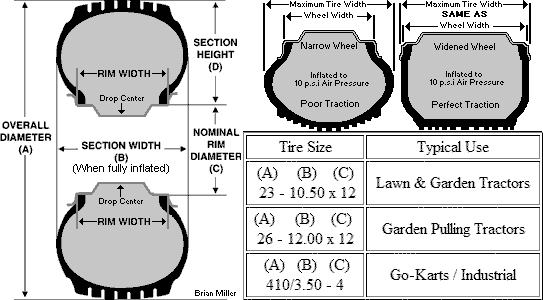
As a rule of thumb, more weight equals more pressure. To see the same performance in their tires, heavier riders should utilize a greater psi than lighter riders, whether they're competing in the Tour de Whatever or tearing up the backwoods. To put things in context, someone who weighs 200 pounds will probably want to pump in roughly 20 psi more than someone who weighs 160 pounds. There isn't a certain sliding rule for this, so experiment with the pressure to determine what works best for you. Keep in mind that rear tires tend to carry more weight than front tires, so make any required adjustments.
A popular question among casual bikers is "How often should I inflate my tires?" The answer is contingent on how frequently and how hard your bike is. Some people use the pump every few days, while others use it once a week, and yet others use it even less frequently. Even if you or your kids have been leaving your wheels in the garage for months, air will eventually seep out. As a result, just like a car, it's always a good idea to inspect your tires before each trip as a bike safety best practice. It's especially important if it's been a while.
Even if you or your kids have been leaving your wheels in the garage for months, air will eventually seep out. As a result, just like a car, it's always a good idea to inspect your tires before each trip as a bike safety best practice. It's especially important if it's been a while.
In a nutshell, don't do both. You run the risk of blowing the tube if you overinflate it, either during pumping or while riding, due to sudden or constant contact. Pinch flats can occur if the tire is underinflated. When you hit a bump with an underinflated wheel, the tube gets compressed between the rim and the tire casing. This not only harms the tire, but it can also harm the rim. Flat tires also slow you down and force you to pedal harder, which is not fun.
There are two types of bike pumps
Hand pumps are necessary for each avid cyclist, but they are more difficult to use and take longer to fill the tire.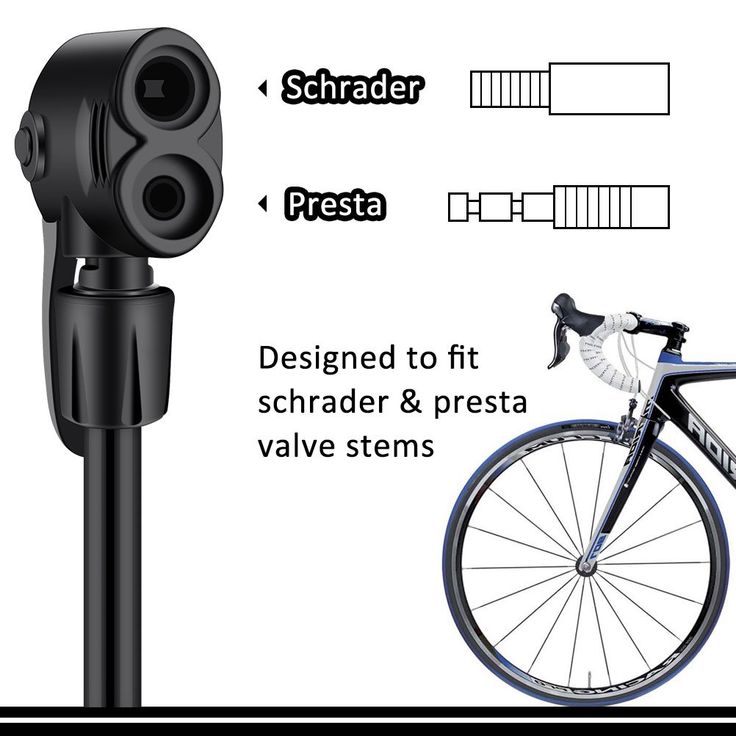 However, because they're portable, you'll always have your pump with you. Any long-distance bike trip would be silly if you didn't have your trusty hand pump and puncture repair kit.
However, because they're portable, you'll always have your pump with you. Any long-distance bike trip would be silly if you didn't have your trusty hand pump and puncture repair kit.
Floor pumps are the professional's pick since they work so well. They're easier to use and connect, and they'll fill your tires up considerably faster than a manual pump. Some come with gauges, which eliminate
1) The need to switch between a pump and a standalone gauge, or
2) Sheer guesswork if you're really lazy.
Expert bikers, on the other hand, are wary of floor pumps with gauges because the gauge's accuracy varies and can be off by as much as 10 PSI. On the bright side, if the gauge is constant, you can compute the difference and compensate by adjusting your goal PSI.
It’s worth saying again: Tire pressure is crucial.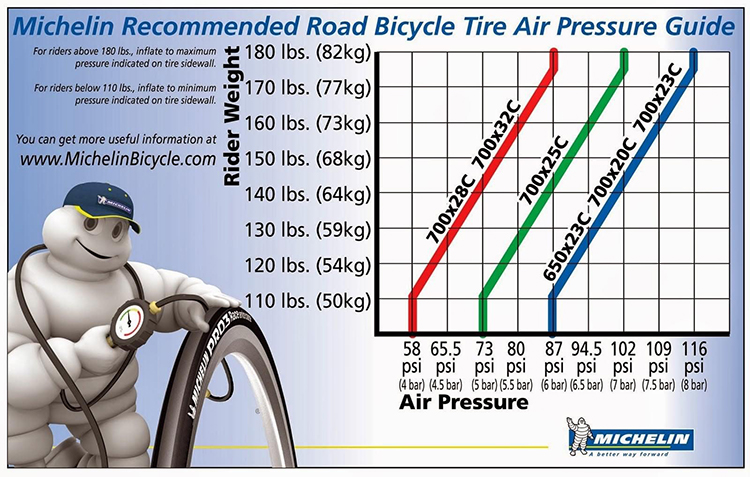 While we strongly recommend that you purchase a tire gauge, learning how to estimate tire pressure by look and feel can come in handy for the times you may be without. Either way, always be vigilant with your tire pressure.
While we strongly recommend that you purchase a tire gauge, learning how to estimate tire pressure by look and feel can come in handy for the times you may be without. Either way, always be vigilant with your tire pressure.
Bicycles.StackExchange
LiveStrong
When it comes to Biking, a lot of riders will tell you just how important your tire pressure is.
Whether you are running tubes or tubeless, air pressure is something you must always regulate.
Unfortunately, getting the right tire pressure can be a challenge for most new riders. This is even something that affects experienced cyclist.
For fear of under-inflation, a lot of riders will find themselves riding around on over-inflated tires.
Even worse, it can be hard to tell if your bike tires need more air.
In this article, we help you recognize some of the symptoms of low tire pressure, along with ways you can better maintain your bike tire pressure.
You know your bike tires need air if you can feel your rim hit whenever you go over obstacles, if your bike feels spongey or delayed in response, if you feel unsteady during turns, or if you see a considerable amount of tire sag once you sit on the bike. In this article we help you notice the signs of low bike tire pressure, along with a few tips to help you add the correct tire pressure.
Like I mentioned earlier, there are a few telltale signs that you have low tire pressure.
To help you better recognize these signs and prevent them, we will further explain what to look for and how to fix it.
Not having enough air in your bike tire can be frustrating.
On top of that, running too low of a tire pressure can be dangerous and possibly damaging to you or your bike.
Running the correct tire pressure will not only keep you safe, it will help you get the most out of your bike.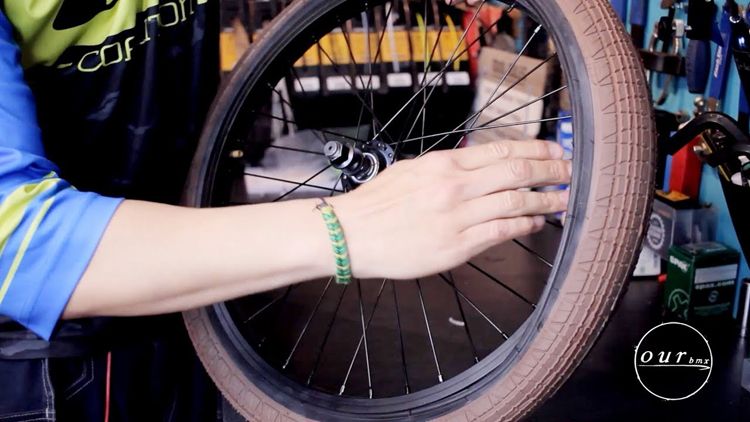
Your tire needs to be able to conform just enough to maintain grip but should also be stiff enough to handle obstacles without hitting the rim.
Finding a balance can be tough in the beginning, but there are a few ways you can tell if your bike tire needs more air.
Whether you ride a Road Bike or a Mountain Bike, your bike tires are meant to be stiff enough to absorb the blow from most obstacles.
Since most of your weight is held towards the back of your bike, it is especially important to have enough air pressure in the rear bike tire.
If your tire does not have enough tire pressure, the tire will bottom out, making the obstacle strike your actual rim.
Rims are not meant to handle the blows and strikes that a bike tire does.
In fact, you can easily damage your rims, making it impossible to properly seal.
Like I mentioned before, the rear bike tire will handle most of your bodyweight.
This is especially true when you are turning at a fast rate of speed.
As you start to put more stress on that rear tire, it will want to fold over and conform to the ground.
If your bike tire pressure is low, your tire will lose its shape and start to fold over, making you feel unsteady.
In order to have traction, your bike tires conform to keep as much surface area in contact with the ground.
While this comes down to making sure you do not have too much air pressure, there is also an issue with running too low of tire pressure.
With too low of bike tire pressure, your tire conforms too much. This give you more traction, but also results in more friction.
This will make it harder for you to get your bike moving, making pedaling more laborious.
On top of that, you lose the bounce and responsiveness that comes with properly inflated tires.
It will take more of your energy to turn the bike and maneuver it how you need to.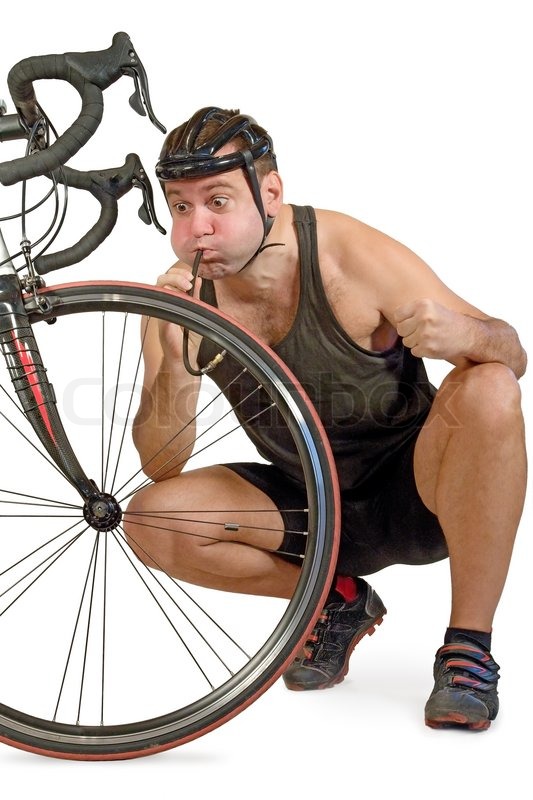
If you notice any of the symptoms mentioned above, or are suspicious that your bike tires need air, you should always give them a check before riding.
Luckily, the ways to check your bike tires are relatively inexpensive and easy.
If you have a tire pressure gauge and a tire pump, you should have no problem getting the right PSI added to your tires.
One of the best things to have is a pump and gauge combo like the Bell Airstrike 850. This is a great pump because it is small and works on both schrader and presta valves.
If you are without a tire pressure gauge, you may have to get a little creative.
Like I said, checking tire pressure with a gauge is really easy and therefore, I recommend it.
Check and match recommended PSI on side of tire – If you have a tire pressure gauge, you can use it to check your tire pressure against the recommended PSI engraved on the tire sidewalls.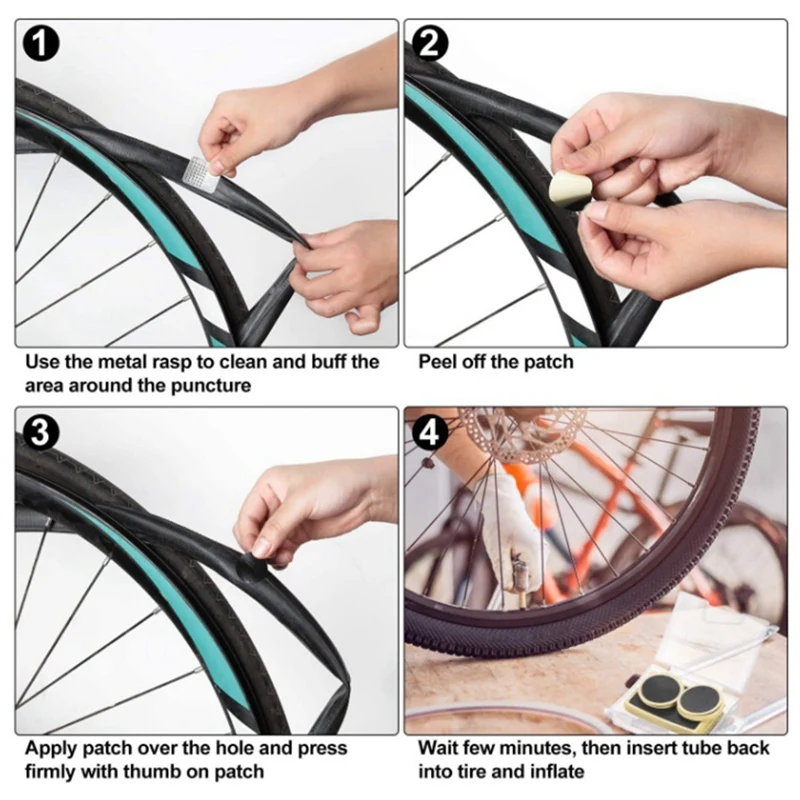 Use a tire pump to add and remove air, until you get the correct PSI.
Use a tire pump to add and remove air, until you get the correct PSI.
Check and match recommended PSI for your weight – You can also use a guide like this one from Bicycling.com to see what the recommended PSI is for your weight. Once you find a suitable range of pressures, use a tire pump to match the air in your tire to the pressure recommended by the guide.
If you do not have a tire pressure gauge, its going to be hard getting the exact PSI you need, however, you are not out of the fight yet.
If you have a little patience and good feel for your bike, you can probably get really close to the correct tire pressure.
Test by Feel – Although its not an exact science, you can actually judge your bike tire pressure by the way your bike feels. In fact, when I am out on the trail without a tire gauge, I often adjust my tire pressure based on the feel of the bike. If your bike feels sluggish and you keep banging the rim, you definitely need to add air. On the flip side, if you are bike feels to bouncy or jittery and you lose traction, you will need to let some air out of those tires.
If your bike feels sluggish and you keep banging the rim, you definitely need to add air. On the flip side, if you are bike feels to bouncy or jittery and you lose traction, you will need to let some air out of those tires.
Thumb Check – An age-old trick handed down from generation to generation is the ole “Thumb Check”. This involves filling the bike tire with air and then pinching the tire just above the rim to feel how tight it is. This is not too reliable and usually follows up a visually sag check, however, its been around this long for a reason.
Puddle Trick – Experimental* – Although I have not personally tried this, some riders have recommended the “Puddle Test”. This involves riding through a puddle to see how high the water comes up on the tire walls. If it is too high, it means your tires do not have enough air in them. I am a little suspicious on the physics of this one, so let me know if you have any luck.
Regardless of how creative you are, it can be a pain checking your tire pressure without a gauge.
To save you the trouble of having a gauge and a pump, or not having one at all, you can actually get a bike tire gauge and pump combo.
I recommend the Bell Airstrike 850, not only is this a low profile pump, it also fits Schrader and Presta valve tires.
Depending on how often you ride and what you ride on, there are certain intervals where you should check your bike tire pressure.
Unless you experience any issues, you should only have to check your bike tire pressure about once per week.
Depending on how you review your rides, you may even want to check your tire pressure before each ride.
Although bike tires and tubes have come a long way, they still experience the occasional leak.
In fact, a standard bike tire will lose a few PSI per week.
And chances are, if you feel like you are always putting air in your tires, you are probably just experiencing the normal leaking interval most tubes have.
To help you decide if this is your case, here is a rough estimate of how often you should add air to your bike tires.
Road Bike – Road Bike tires are a lot skinner and hold a higher PSI than you would see in most Mountain Bikes and Hybrids. Since Road Bike tires need a near perfect tire pressure to perform properly, you should try to air up your Road Bike tires 1-2 times per week.
Mountain Bikes and Hybrids – Mountain Bikes and Hybrids are a little more forgiving when it comes to the acceptable range of tire pressures. Regardless, running the correct tire pressure ensures safety and performance out on the trail, so you should still try to air them up at least once per week.
Bike tires are meant to operate at the recommended PSI engraved on the sidewalls, and for the recommended weight of the rider.
Again, this is something that affects safety and performance.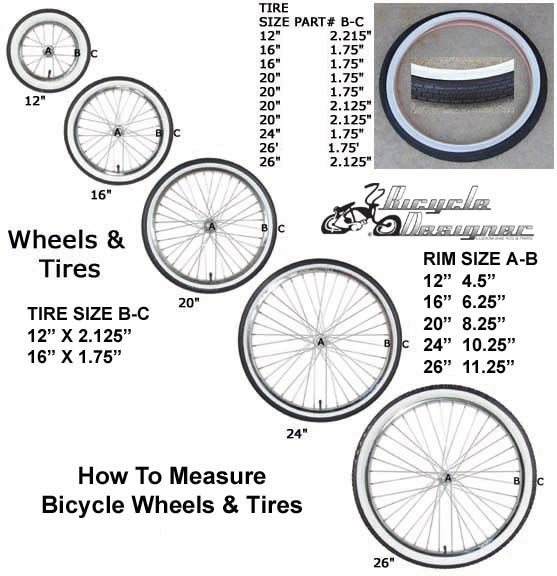
Most riders will err on the side of over-inflation when it comes to tire pressure, which is just as dangerous as under-inflation.
If you add too much air in your bike tires, they will not have as much traction and will be more prone to leak or burst.
Although you are less likely to under-inflate your tires compared to adding too much air, it is still common.
Where over inflated tires lose their performance, under-inflated tires can fail altogether.
Not only will it be harder to maintain speed, you will not be able to ride as aggressive as you would like.
In conclusion, having the correct air pressure in your Bike tires is really important.
There are many ways to tell if your tires need more air and it is really easy to get the correct tire pressure.
Good luck getting your tires aired up and safe riding!
When buying a bicycle for themselves, many do not even think about the fact that the convenience and comfort when riding it is achieved by properly selected tire pressure. The service life of the bicycle, the speed of riding, the degree of tire wear, safety, control of the two-wheeled friend depends on how the wheels are inflated.
The service life of the bicycle, the speed of riding, the degree of tire wear, safety, control of the two-wheeled friend depends on how the wheels are inflated.
Many cyclists believe that inflating the tires is only necessary for a good bike ride. However, flat tires have a wider area of contact with the road, which means that grip will be better, but it will be very difficult to accelerate to a speed of 30-35 km / h on such tires.
When inflating your tires, you should always consider the type of terrain or surface you will be driving on. If the walk is supposed to be on an asphalt road, the tire pressure of the bicycle should be close to the maximum allowable value. Elastic wheels on a flat surface will provide a smooth rolling and high speed of movement.
For cross-country riding with unpaved paths, it is better to set the tire pressure to medium tolerable, so that you can ride long distances in comfort and convenience. At high pressure, the grip of the wheel with the road will be minimal, respectively, all holes, pebbles, and bumps on the road will be sensitive. And with flat tires, the likelihood of damage to the wheel or puncture of the chamber increases.
At high pressure, the grip of the wheel with the road will be minimal, respectively, all holes, pebbles, and bumps on the road will be sensitive. And with flat tires, the likelihood of damage to the wheel or puncture of the chamber increases.
In order to protect yourself on the road, as well as to keep the bike or its individual parts intact, you need to know exactly the lower and upper limits of permissible values, to what pressure the bicycle wheels can be pumped.
Information about tire pressure gives you an advantage when cycling:

Forget the old "grandfather" way to check the wheel with finger pressure. No need to rely on tactile sensations, trying to feel with your hand the degree of rubber penetration on the tire. The air leaves the wheel gradually, through the pores in the rubber. Within 2-3 weeks, the pressure decreases by 0.1-0.2 atmospheres, but you cannot determine this with your fingers. The exact value at any time will help determine the pressure gauge that every cyclist should have in his arsenal. With its help, it is simple, with a minimum error, the level of pressure in bicycle tires is measured. A pump with a pressure gauge (floor or manual) will become an indispensable tool for cyclists.
There are three standard values in which bicycle tire pressure is measured.
kPa = 14.504 PSI
All these units are used to some extent - in different countries, by different manufacturers. For residents of Russia and the post-Soviet space, the change in bars is more familiar, since this unit is clearly associated with the pressure of the 1st Earth's atmosphere at ocean level. In America and Western Europe, a popular unit is PSI, as they actively use pounds and inches in measurements. Pascals are the least used unit of measurement, but the most modern. Some bicycle manufacturers write data on the wheels about the allowable pressures in all three systems.
For residents of Russia and the post-Soviet space, the change in bars is more familiar, since this unit is clearly associated with the pressure of the 1st Earth's atmosphere at ocean level. In America and Western Europe, a popular unit is PSI, as they actively use pounds and inches in measurements. Pascals are the least used unit of measurement, but the most modern. Some bicycle manufacturers write data on the wheels about the allowable pressures in all three systems.
Manufacturers indicate on the sidewall of the tire how many atmospheres to pump the bicycle wheels. Specifies the range within which the owner of the "iron horse" determines the desired values, depending on the specific factors of riding his bike. Values in the range are labeled from min to max, in two or all three dimensions. Numbers up to 10 are atmospheres (or BAR), tens-hundreds are PSI, and six-digit values \u200b\u200band with the prefix “k” / kilo are Pascals.
When inflating a tire, you must strictly follow the manufacturer's recommendations and try not to go beyond both the minimum and maximum pressure levels indicated on the tire. Moreover, it is better to leave a small margin of 0.2-0.5 BAR, both in one direction and in the other, so that the tire does not burst.
Moreover, it is better to leave a small margin of 0.2-0.5 BAR, both in one direction and in the other, so that the tire does not burst.
The pressure in the wheel is kept by the tire, not the tube, so there is no single standard for its value. There are several significant factors that determine how much you need to pump the wheels on a bicycle.
Tire type is determined by the surface of the track that the cyclist will predominantly ride on. Accordingly, the level of inflation of the bicycle wheel will be different. There is a direct dependence on the roughness of the tread and the width of the wheel - the more lugs and the wider the wheel, the lower the pressure should be. Empirically, cyclists quickly determine how many atmospheres should be in the tires of their bicycle
Many cyclists do not think about the fact that air temperature affects the pressure level in bicycle tires. From the course of school physics, we recall that when heated, bodies expand. This means that in hot sunny weather, the pressure inside the air chamber will increase without additional pumping. Conversely, on cold winter days, a decrease in tire pressure is quickly felt due to low temperatures. So, when going for a bike ride in the cold season, the pressure indicators need to be adjusted a little higher than usual, and in the summer heat, let the air out a little. It is worth noting that when going on a bike ride, you should always take into account the weather conditions.
From the course of school physics, we recall that when heated, bodies expand. This means that in hot sunny weather, the pressure inside the air chamber will increase without additional pumping. Conversely, on cold winter days, a decrease in tire pressure is quickly felt due to low temperatures. So, when going for a bike ride in the cold season, the pressure indicators need to be adjusted a little higher than usual, and in the summer heat, let the air out a little. It is worth noting that when going on a bike ride, you should always take into account the weather conditions.
It is important to consider the load on the bike created by the weight of the rider, especially the fact that most of it is on the rear wheel. Therefore, the degree of its pumping should be slightly higher than the front, the optimal difference is 10%.
To calculate the optimal tire pressure for a bicycle, given the weight of its rider, you can use the table:
Rider weight (kg) Pressure (atmosphere) Pressure (PSI)
The nature, riding style and type of bicycle also affect tire pressure. Buyers who prefer an active pastime often opt for mountain bikes with 26-inch wheels, which ride well both on city streets and in rough terrain.
Buyers who prefer an active pastime often opt for mountain bikes with 26-inch wheels, which ride well both on city streets and in rough terrain.
To understand to what pressure to inflate the wheels of a bicycle, it is necessary to take into account the features of both the bike itself and other, at first glance, weightless factors. For example, weaving threads on a tire, rim thickness, driving style. The likelihood of a tire coming off a wide rim is much less than a narrow rim, because a wider rim will hold the tire better than a thin one. Mountain biking already by its name suggests the presence of a difficult surface on the track, with possible obstacles and bumps. The driving style is more aggressive than on a smooth, calm trajectory, it obliges you to increase the tire pressure to a level slightly less than the upper limit.
The diameter of the wheel will also affect the selection of the optimal pressure value, since the larger it is, the higher the volume of air pumped will be. However, for mountain bikes it is not so important whether the wheel diameter is 26 or 29 inches, it is much more necessary to pay attention to the parameters of the rider's weight and the type of track.
However, for mountain bikes it is not so important whether the wheel diameter is 26 or 29 inches, it is much more necessary to pay attention to the parameters of the rider's weight and the type of track.
There are no hard and fast rules about how much you need to inflate the wheels on your bike. There is common sense, experience, practice. Manufacturers can recommend certain values, but only the owner himself will determine exactly which road he will ride, in what weather conditions he will drive, take into account his weight parameters or not. The decision, what pressure in the wheels will be ideal, is sure to be found.
Road tire pressure
Let's start with vehicles used on asphalt. Much easier with him. If the pressure is strong, then the roll is good. It is worth looking at the side surface of the tire. Usually they write a valid value in atmospheres (bar) or psi.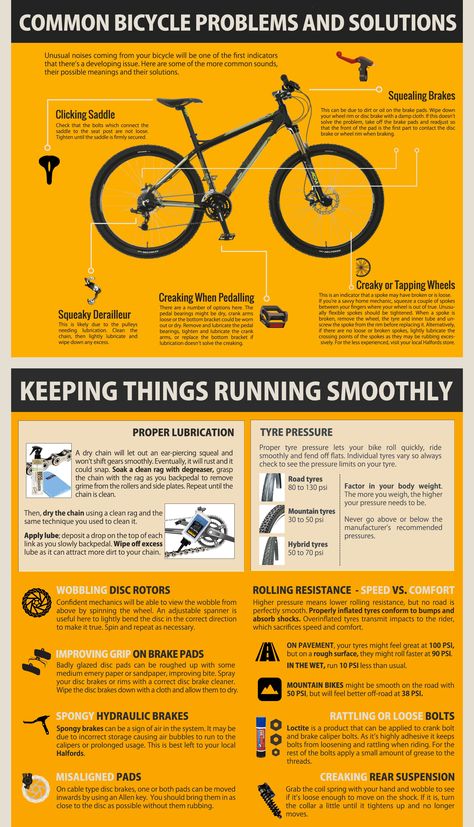 It's easier to pump up to the maximum and enjoy the speed. A floor pump with a pressure gauge is ideal for quickly pumping up tires and knowing exactly what pressure is in the chambers. Pumping up to 11 atmospheres with a conventional pump is quite difficult. It is worth noting that after 2-3 weeks the pressure will drop by a couple of atmospheres. You can't feel it with your fingers. A floor pump or a manual pressure gauge is perfect for this. In the event that you pump up incomplete pressure, a breakdown called a "snake bite" can occur. Too much collision of the wheel with a hard surface leads to breakdown to the rim. As a result, two holes appear on the camera, which resemble a snake bite.
It's easier to pump up to the maximum and enjoy the speed. A floor pump with a pressure gauge is ideal for quickly pumping up tires and knowing exactly what pressure is in the chambers. Pumping up to 11 atmospheres with a conventional pump is quite difficult. It is worth noting that after 2-3 weeks the pressure will drop by a couple of atmospheres. You can't feel it with your fingers. A floor pump or a manual pressure gauge is perfect for this. In the event that you pump up incomplete pressure, a breakdown called a "snake bite" can occur. Too much collision of the wheel with a hard surface leads to breakdown to the rim. As a result, two holes appear on the camera, which resemble a snake bite.
Mountain bike tire pressure
Mountain bikes are a bit more complicated. It is important to strike a balance between coasting and grip. If the wheel is well inflated, then the rolling will be much better on unpaved surfaces. Although, due to the resulting hardness, it is difficult for the tire to “lick” the surface.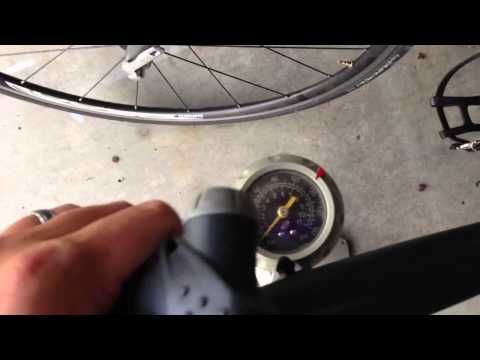 The grip from this deteriorates, while the high-pressure wheel itself has a semicircular shape. Maximum grip will be obtained only when the entire surface of the contact patch is involved. Simply put, the more flattened the wheel, the better the bike will handle, and this can only be achieved by reducing the pressure. But the roll-up suffers from this and there will be a risk of a "snake bite".
The grip from this deteriorates, while the high-pressure wheel itself has a semicircular shape. Maximum grip will be obtained only when the entire surface of the contact patch is involved. Simply put, the more flattened the wheel, the better the bike will handle, and this can only be achieved by reducing the pressure. But the roll-up suffers from this and there will be a risk of a "snake bite".
MTV tires are most often marked with the pressure range. It usually varies from 2.5 to 4.5 atm. With this range, 3-4 atmospheres is considered an acceptable pressure. But it will not be possible to say any definite figure, since there are too many accompanying factors. Much also depends on the rubber itself. With the same pressure, it can behave differently. An important factor is the width of the tire. The width of the tire, the weight of a person greatly affect the wheel. It would be nice to set up an experiment, taking a pressure gauge with you. With it you will be able to find the ideal pressure. First, pay attention to how this or that pressure affects tire deformation, and then look at how the bike rides with this pressure. Try to find the golden mean with which you will be comfortable.
First, pay attention to how this or that pressure affects tire deformation, and then look at how the bike rides with this pressure. Try to find the golden mean with which you will be comfortable.
Pressure in different types of tires
Low pressure is not suitable for semi-slick, it will negate all its advantages. The essence of such a tire is that, due to its semicircular shape, a smooth tread (located in the center of the tire) comes into contact with the road on hard surfaces. And when the wheel hits soft ground, the side parts are involved. A poorly inflated tire will flatten out and the asphalt will rub against the lugs. For this reason, you need to pump such wheels as much as possible.
Classic cross country tires have a width of 2.1-2.3". For them, the ideal pressure is from 3 to 4 atmospheres. They do not have very pronounced lugs. These wheels are suitable for forest roads. Many athletes in this sport, like tubeless tires are typically used
Extreme Riding Tires
These are typically used for mountain riding and are 2.